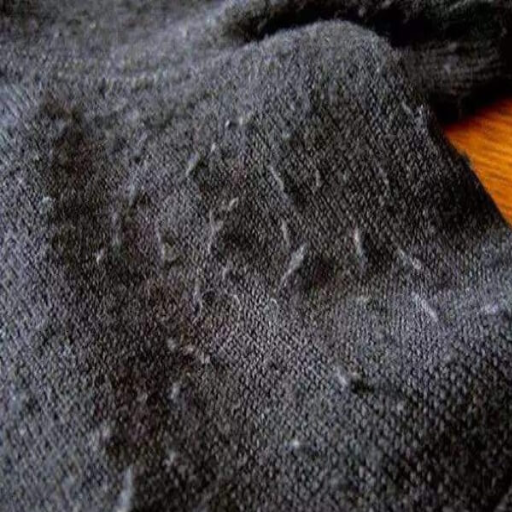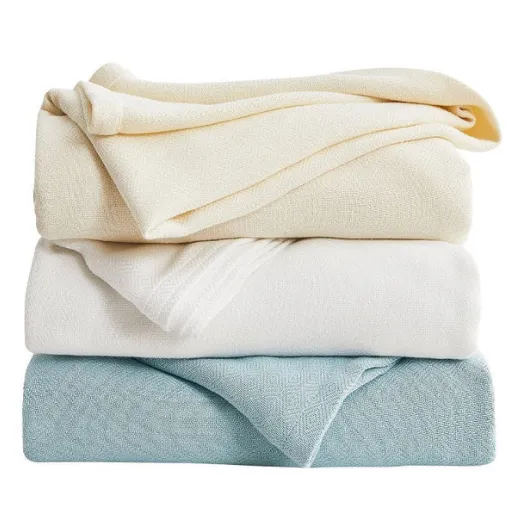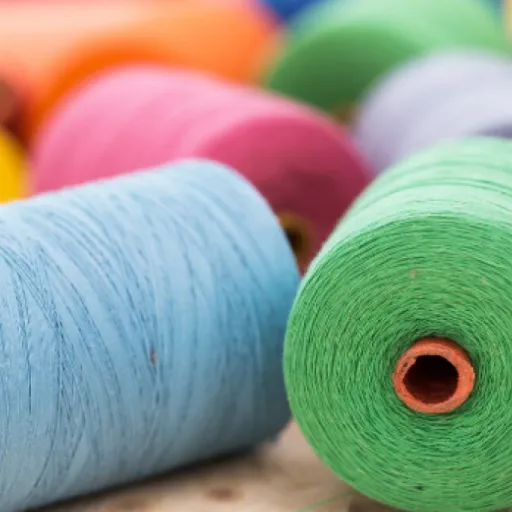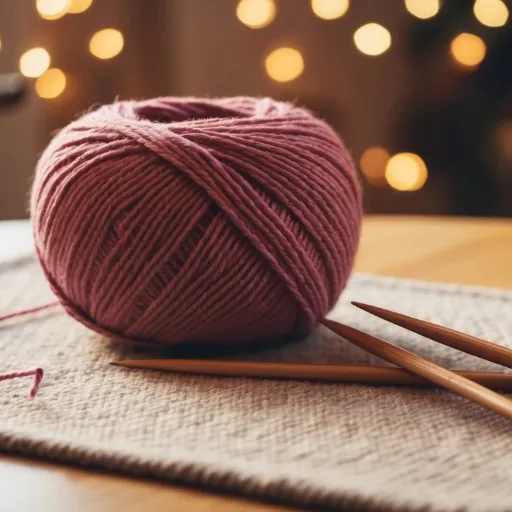Known for its multi-purpose use, affordable price, and vibrant color options, acrylic yarn is one of the most popular choices among crafters. But what is it made from, and what features make it stand out to knitters, crocheters, and craftsmen in general? This post aims to address these questions and explore the multifaceted features of acrylic fiber, including its composition, unique properties, and the reasons why it has become indispensable for both daily and specialized projects. As a seasoned crafter or a novice in the creative world, understanding the composition and the merits of acrylic yarn can be very helpful in making better decisions, especially for your next creation. Prepare yourself to delve into the incredible journey and crafting utility of this synthetic fiber!
Acrylic Yarn: Definition and History
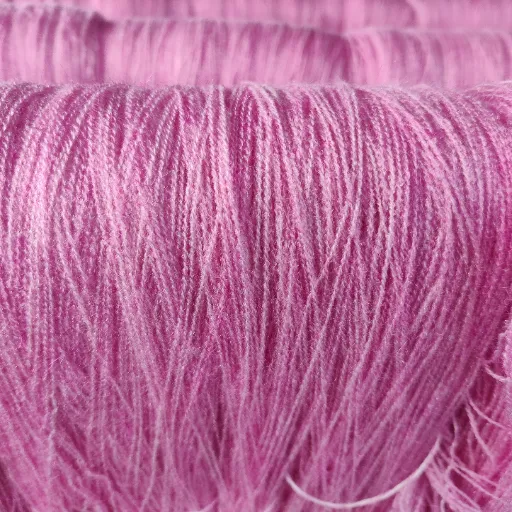
Acrylic yarn is a synthetic fiber produced from acrylonitrile, which comes from petroleum. It was developed in the 1940s and gained widespread use due to its low cost and durability. Unlike natural fibers, acrylic yarn does not shrink and is resistant to moths and mold. Because of this, it serves as a perfect substitute for dual garments and crafting needs. As the years have passed, manufacturing has improved the softness and appearance of its products. Because of that, it is now the most used for making blankets, sweaters, scarves, and other similar projects.
What is Acrylic Yarn?
Acrylic yarn is a manufactured fiber produced from acrylonitrile monomers, an element usually obtained from petroleum or natural gas. Its low price, long-lasting nature, and simple maintenance have marked it as an essential component in the crafting and textile industries. Because it appeals to both beginner and advanced crafters, it is a popular choice among them. For that matter, it is warm, lightweight, and comes in numerous colors. Sweaters, blankets, and hats, as well as a multitude of other crafting projects, benefit from its use due to the acrylic yarn being machine washable and quick-drying. Modern manufacturing has enabled the synthetic production of certain types of acrylic yarn, allowing them to replicate the softness of wool and provide comfort and ease.
Brief History of Acrylic Yarn
Acrylic yarn is a synthetic fiber developed in the mid-20th century. Its purpose was to serve as an alternative to natural fibers such as wool and cotton. Its development is closely related to the polymer known as polyacrylonitrile, a material initially used for the production of plastics. The introduction of this fiber to the textile industry brought forth a new set of challenges and opportunities for crafting and knitting. For the first time, there was an option that was not only durable but also affordable and versatile. Acrylic yarn production on a large scale began in the 1950s and 1940s. Ever since, manufacturing processes have undergone enormous changes in an attempt to improve the quality and texture of the fiber. The ease of access to acrylic yarn, combined with its versatility and low maintenance, continues to make it a go-to option for projects of all scales.
Key Characteristics of Acrylic Yarn
Durability
Acrylic yarn is highly resistant to abrasions and other forms of damage, making it exceptionally durable. It continues to look good even after multiple uses and washes.
Affordability
Acrylic yarn is an economical alternative, and as such, it can be afforded by a broader consumer base.
Lightweight and Soft
The feeling of acrylic yarn is light and soft, and in fact, mimics natural fibres. Modern production methods have refined the feeling of acrylic yarn.
Vibrant Colors
Designing works can be enriched with numerous bright colour options, which can be enabled by the acrylic yarn hues that are both intense and durable.
Ease of Care
Unlike delicate materials like wool, this yarn is low-maintenance, as it is quick-drying, machine-washable, and therefore requires little care.
Non-Allergenic
People with allergies triggered by natural fibres like wool will undoubtedly benefit from Acrylic yarn, which is less irritating and synthetic.
Versatility
For different styles and stitch patterns, Acrylic yarn can be effortlessly molded into various types of clothing, home furnishings, and even decorative and utility craft items.
Composition and Production Process of Acrylic Yarn
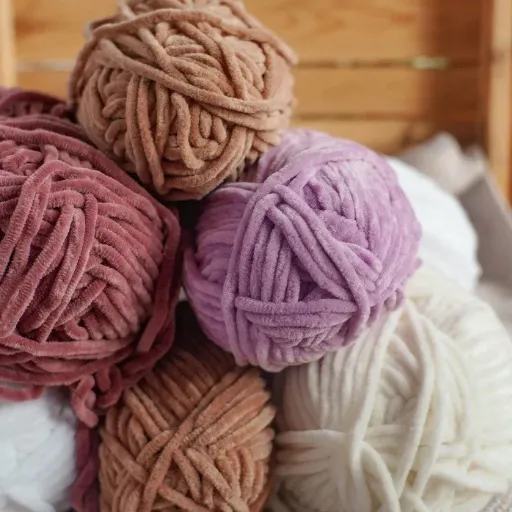
Acrylic yarn, a type of synthetic yarn, is made from polyacrylonitrile fibers and other polymers manufactured using chemical methods. Like with other polymers, polyacrylonitrile is dissolved in a solvent to produce a solution. This solution is excreted through spinnerets to obtain long fibers. The fibers undergo stretching, drying, and crimping to develop texture and stretch. The fibers are then spun into yarn for use in knitting and other textile applications. Unlike other materials, acrylic yarn is designed to be durable, have bright colours, and be cost-effective.
What is Acrylic Yarn Made Of?
Acrylic yarn consists of synthetic polymer fibers, primarily polyacrylonitrile (PAN) fibers, which are a form of plastic. To classify yarn as acrylic, it must have at least 85% acrylonitrile units. These polymers are formed by polymerization, a chemical process in which monomers are chemically bonded to create long chains. The addition of chemicals such as vinyl acetate or methyl acrylate during production can improve softness, flexibility, or dye uptake. Such alterations enable acrylic yarn to resemble wool and other natural fibers, while also being resistant to moisture, mildew, and shrinking.
Production Process of Acrylic Yarn
The creation of acrylic yarn begins with the production of acrylonitrile, the primary monomer used in its manufacture. As with its output, propylene ammoxidation is commonly used to produce acrylonitrile from its petrochemical precursors. In the next step, polymerization occurs, where acrylonitrile monomers are correctly assembled in water with initiators to form long polymer chains.
The resulting polymer from the polymerization step is then formed into fibers using either dry or wet spinning methods. With damp spinning, the polymer is dissolved with a solvent and then extruded into a coagulation bath to form the fibers. Dry spinning uses hot air to evaporate the solvent as the fibers are extruded. After spinning, the fibers are stretched to align their molecules, resulting in improved strength and elasticity.
Before being spun into yarn, the fibers are crimped, cut, and dyed as necessary. There have also been advancements in the process, enabling the recycling of parts of the material and reducing energy use during production. These new methods aim to incorporate sustainable production methods into the manufacturing of acrylic yarn, thereby satisfying the needs of both customers and the environment simultaneously.
Comparison of Acrylic Yarn with Other Types of Yarn

Acrylic yarn is best known for its low price tag, high durability, and low-maintenance care, especially in comparison to natural fibers like wool or cotton. It’s also different from wool in that it is lightweight, hypoallergenic, and resistant to moths and pests. Additionally, it’s more colorfast, retaining its hue after multiple washes and prolonged exposure to sunlight. On the other hand, it’s less breathable and comfortable in hot weather than natural fibers. In relation to cotton, acrylic yarn has a greater stretch and recovery, but it may have a lesser softness and biodegradability. Often, to strike a balance between cost, comfort, and function, blends combine acrylic with other natural fibers.
Acrylic vs. Cotton Yarn
| Key Point | Acrylic Yarn | Cotton Yarn |
|---|---|---|
| Material | Synthetic, petroleum-based | Natural, plant-based |
| Texture | Soft but can feel scratchy | Soft, crisp, and structured |
| Breathability | Less breathable | Highly breathable |
| Durability | Prone to pilling and stretching | Hardwearing and long-lasting |
| Care | Machine washable, low maintenance | Machine washable, may shrink |
| Cost | Affordable | More expensive |
| Eco-Friendliness | Non-biodegradable, sheds microplastics | Biodegradable, eco-friendly |
| Best Uses | Blankets, throws, and cozy items | Wearables, dishcloths, and summer items |
| Appearance | Vibrant colors, less defined stitches | Crisp, well-defined stitches |
| Weight | Lightweight | Heavier |
Acrylic vs. Wool Yarn
| Key Point | Acrylic Yarn | Wool Yarn |
|---|---|---|
| Material | Synthetic, petroleum-based | Natural, animal-based (sheep, alpaca) |
| Texture | Soft but can feel coarse | Softer, natural feel |
| Warmth | Less insulating | Excellent warmth |
| Durability | Highly durable | Prone to wear and shrinkage |
| Care | Machine washable, low maintenance | Hand wash or delicate cycle |
| Cost | Affordable | More expensive |
| Eco-Friendliness | Non-biodegradable | Biodegradable |
| Best Uses | Blankets, toys, and everyday items | Sweaters, scarves, and winter wear |
| Allergy Concerns | Hypoallergenic | May cause allergies |
| Appearance | Vibrant colors | Natural, earthy tones |
Acrylic vs. Blended Yarns
| Key Point | Acrylic Yarn | Blended Yarns |
|---|---|---|
| Material | 100% synthetic | Mix of synthetic and natural fibers |
| Texture | Soft but can feel coarse | Softer, it combines the best of both fibers |
| Durability | Highly durable | More durable than natural fibers |
| Care | Machine washable | Care depends on the fiber blend |
| Cost | Affordable | Varies by blend composition |
| Eco-Friendliness | Non-biodegradable | More eco-friendly with natural fibers |
| Best Uses | Everyday items, blankets | Versatile for wearables and accessories |
| Appearance | Vibrant colors | Balanced colors and textures |
| Warmth | Moderate | Warmer with wool or natural blends |
| Allergy Concerns | Hypoallergenic | May vary by natural fiber content |
Common Uses of Acrylic Yarn
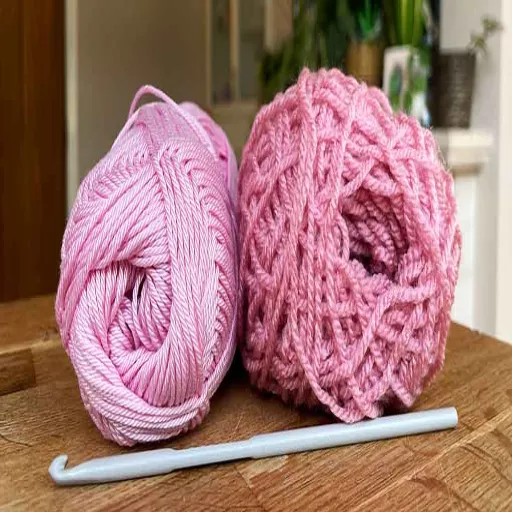
Due to its low cost, strength, and ease of maintenance, acrylic yarn has a wide range of applications. It is commonly utilized for:
- Blankets and Throws: Ideal for adding warmth and vibrancy to your home’s decor.
- Clothing: Used in making sweaters, scarves, and hats, among other garments.
- Toys and Amigurumi: Intended for use in making plush and other crafted toys.
- Accessories: Suitable for crafting gloves, headbands, bags, and other items.
- Home Decor Items: These can be used to create table runners, cushion covers, rugs, and other home decor accessories.
Crafting with Acrylic Yarn
The popularity of acrylic yarn among crafters can be attributed to its affordability, convenience, and durability. It’s the ease of use and lightweight nature of acrylic yarn that make it so popular for a diverse range of projects. Hands and fingers working with it do not tire easily, allowing people to complete their projects more quickly. Lightweight acrylic yarn washes easily and does not shrink. It is far more economical than natural yarns and comes in a wide variety of vivid shades and patterns. Moreover, the forgiving nature of acrylic yarn makes it a popular choice among beginners. With yarn that is simple to work with, learners can more easily master valuable knitting and crocheting skills, further enhancing their crafting experiences. All these reasons explain why both amateur and expert crafters continue to use the yarn.
Fashion Items Made with Acrylic
Because of its versatility and low cost, acrylic has become a popular choice in the fashion industry. Acrylic yarn is used in the production of sweaters, scarves, and hats, providing desired warmth and comfort at a low cost. Acrylic is also used in the production of lightweight and durable items, such as shawls, gloves, and socks. Acrylic is not limited to accessories; it is also used in the production of attention-grabbing pieces, such as bright, multicolored cardigans and fashionable outerwear. With the development of synthetic materials, high fashion and everyday apparel can utilize acrylic blends that combine luxury fibers for a refined look.
Home Decor Using Acrylic Yarn
The use of acrylic yarn in home decoration is gaining popularity due to its adaptability, affordability, and ease of handling. It is often and warmly used for crafting cozy throws, decorative pillows, and eye-catching wall hangings. The assortment of hues offered can satisfy any creative demand to complement an interior design approach, whether it’s a modern minimalist or a rustic boho style. Furthermore, the durability and the ability to withstand fading of acrylic yarn are advantageous when making area rugs and table runners that face continuous wear and tear. With acrylic yarn, a personal touch can be added to the living space by crafting functional and beautiful items.
Tips for Selecting High-Quality Acrylic Yarn
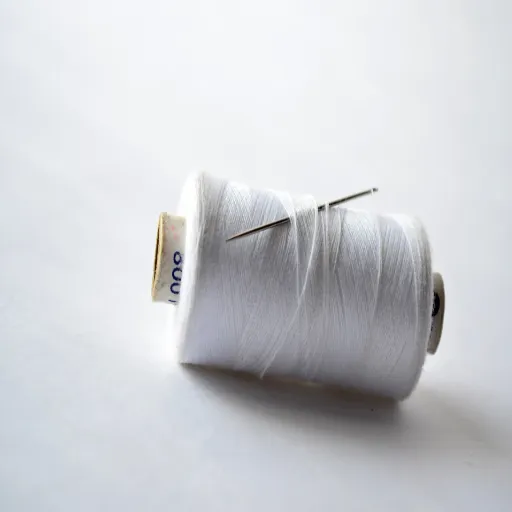
1Check the Fiber Quality
Seek out yarns marked as “premium” or “high-quality” acrylic, since such yarns tend to be softer and more durable. Stay away from yarns that are too stiff or scratchy.
2Read Customer Reviews
Customer feedback can reveal how a yarn performs, how gentle it is, and how well it retains its softness and resists pilling after prolonged use.
3Examine the Dye Quality
Look for yarn with a uniform color for the entire skein. Inconsistent dyeing can result in uneven patches that stand out.
4Test for Strength and Flexibility
Lightly pull a section of yarn to inspect its strength and flexibility. Quality yarn will not snap and will stretch minimally to retain its shape.
5Consider Washability
If you are making garments or blankets for everyday use, it is best to use yarns that can be washed in a machine to simplify maintenance.
6Look at the Ply Count
Yarn with a higher ply count typically offers greater strength and resistance to damage. They tend not to fray or split as easily during use.
7Match Yarn to Project Needs
Assess the yarn’s weight, feel, and shine in relation to the project’s needs to achieve satisfactory results.
8Check the Label for Quality
To determine the quality and care of a yarn, scrutinizing the label is the first step. The label of a yarn often contains the fiber blend, the exercise needle or crochet hook size, and the washing symbols. Look for markings such as OEKO-TEX and organic certifications that demonstrate the yarn conforms to safety and environmental regulations.
9Feel the Texture of the Yarn
Feeling the yarn, my attention zeroes in on how soft, elastic, and comfortable it is in general. That gives me a good idea of whether the yarn will work well for the project I’m considering, combining practicality with an attractive result.
Reference Sources
The following are three professional and authoritative reference sources that you can check to verify and support your article on “what is acrylic yarn made of”. These sources, because of their academic or research nature, are credible:
A Study on Comfort Properties of Oak Tasar Silk Waste and Acrylic Blended Fabrics
Source: Academia.edu
Frequently Asked Questions (FAQs)
Acrylic yarn is primarily made from acrylonitrile, a type of synthetic polymer. This polymer is processed to create acrylic fibers, which are then spun into yarn. The production of acrylic yarn involves a combination of these synthetic fibers, which can also include additives like nylon or polyester to enhance specific properties.
Acrylic yarn is often compared to natural fibers, such as wool and cotton. While it is cheaper than wool and easy to work with, it lacks some of the softness and breathability found in natural yarns. Items made with acrylic yarn tend to be more durable but may not provide the same warmth as garments made from natural fibers.
The pros of acrylic yarn include its affordability, versatility, and ease of care, as it can be washed in a washing machine. However, the cons of acrylic yarn are that it can be less soft than natural fibers and may not be suitable for individuals with sensitive skin. Understanding the pros and cons of acrylic can help crafters make informed decisions.
Yes, acrylic yarn is widely used for knitting and crocheting. Its easy-to-work nature makes it a popular choice for both beginners and experienced crafters. Knitting needles and crochet hooks glide smoothly through acrylic yarn, enabling a wide range of projects, from simple scarves to intricate garments.
Yes, there are various types of yarn within the acrylic category. Acrylic yarns are available in multiple weights, textures, and blends, including those that incorporate fibers such as nylon or polyester. Additionally, some specialty acrylic yarns are designed for specific projects, such as sock yarn, which is made to withstand wear and tear.
Everyday items made with acrylic yarn include sweaters, blankets, hats, and baby clothes. Its durability and ease of maintenance make it an ideal choice for everyday garments and home decor items. Many crafters opt for acrylic when creating gifts or functional pieces.
While acrylic yarn is generally hypoallergenic, some individuals with sensitive skin may find it less comfortable than natural fibers, such as merino wool or cotton. If you are prone to skin irritation, it may be beneficial to try yarns made from natural fibers or blends that include softer materials.
The production of acrylic yarn involves synthetic processes that create fibers from acrylonitrile, whereas natural yarn is made from natural fibers, such as wool, cotton, or linen. The differences between acrylic yarn and yarn made from natural fibers can impact the texture, warmth, and overall feel of the finished product.
Acrylic and nylon are both synthetic fibers, but have different properties. Nylon is often used for its strength and elasticity, making it an ideal material for items that require durability. Acrylic, on the other hand, is valued for its affordability and ease of care. When choosing between acrylic and nylon yarn, consider the specific needs of your project.














